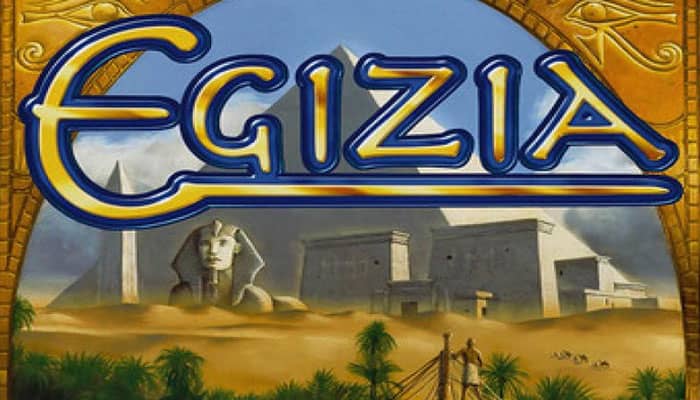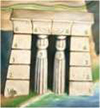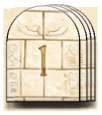
Components

- 1 game board
- 4 player tableaus
- 32 ships (4 colors)
- 96 stones (4 colors)
- 16 construction crew tiles (4 colors)
- 4 quarry start cards
- 4 grain start cards
- 56 Nile cards
- 29 Sphinx cards
- 20 grave tiles
- 4 player sequence number tiles
- 1 water ring
- 4 Skarabäus tiles
- 1 game rules
Setup
1. Place the game board in the middle of the table.
2. The players use 1 player sequence number tile for each player in the game. They shuffle these tiles secretly and each takes one and places it in his play area.
With fewer then 4 players, the players return unused tiles back to the box.
3. Each player takes 1 player tableau in the color of his choice and places it near him on the table (this is his play area).
Each player takes the 4 construction crew tiles in his color and places them on his player tableau.

He places the Joker tile on space 2 of the lower row and the other 3 tiles on space 1 of the upper row.
4. Each player takes 8 ships in his color and places them in his play area.
5. Each player places 24 stones in his color in his play area. From these 24 stones, he uses 4 as follows: He places 1 stone on the scoring track.
The player with 1-Token places his on the last place and so on. He places 1 stone on the top-most space of the stone market, another on the top-most space of the grain market. With both, the sequence does not play a role.
Each player puts the fourth stone as the stone marker on the stone table of his player tableau as shown below:

6. Each player takes 1 quarry start card and 1 grain start card, which he places face-up beside his player tableau. With fewer than 4 players,

7. Shuffle the sphinx cards and place them face-down as a supply on the space on the game board. Each player draws one, looks at it, and places it face-down in his play area. Separately shuffle the 3 sets of cards with the numbers of 1/2, 3/4, and 5 on their backs and place them face-down next to the game board.

8.Place the water ring on the middle of the 3 irrigation spaces of the game board.
9. Shuffle the 20 grave tiles face-down and distribute them on the 12 grave spaces. Return the remaining 8 face- down back into the box. Turn over the first 4 grave tiles.
10. Place the 4 Scarab tiles next to the game board. Whenever a player moves his scoring marker past 50, he takes one as a reminder.

Game Play
Egizia lasts for 5 rounds. In each round, the players can increase the strength of their construction crews, add new quarries or fields, take Nile and sphinx cards, and cooperate in the building of king's graves, obelisks, pyramids, and temples.
The goal is to collect points. Players can earn points immediately for building and points at the end of the game from the sphinx cards.
In each round, the players pass through 7 phases, then the next round begins.
Game Turn
- Lay out Nile cards Pplace ships along the Nile
- Feed construction crews
- Produce stones
- Build
- Bonus for co-operation in building
- Determine player sequence for the next round

1. Lay Out Nile Cards
At the beginning of each round, the players draw 10 Nile cards from the supply and place them face-up on the 10 card spaces on the game board next to the Nile, beginning at the source.
In rounds 1 and 2, players draw from the 1/2 supply, in rounds 3 and 4, they draw from the 3/4 supply, and in round 5, they draw from the 5 supply.
At the end of rounds 2, 4, and 5, players return unused cards from the just-completed supply back into the box.
2. Place Ships Along The Nile
The player with the number  begins and places one of his ships on the Nile space of his choice. Next, the player with the number
begins and places one of his ships on the Nile space of his choice. Next, the player with the number  , then the player with the
, then the player with the  , and finally, the player with the
, and finally, the player with the  . Then, placing continues again with the player with the number
. Then, placing continues again with the player with the number  placing his second ship, and so on. Only 1 ship may float on each space.
placing his second ship, and so on. Only 1 ship may float on each space.
The important rule: a player must always place his new ship further down-river from his already-placed ships.
player can place his ship on the folowing 3 types of spaces:
-

A space with a Nile card: the player first takes the Nile card and then places one of his ships on the now-empty space where the card was.
Afterwards, he executes the action on the card or places it in his play area (see pages 10 and 11 for the descriptions of the Nile cards).
-

Round space: The player places one of his ships on a round space next to the Nile.
Then he executes the action designated by the space (see page 9 for the descriptions of the round spaces).
-
 Building space: the player places one of his ships on an empty building space of his choice. A player may only place 1 ship at each site: the sphinx, the obelisk/graves, and the temples/pyramid.
Building space: the player places one of his ships on an empty building space of his choice. A player may only place 1 ship at each site: the sphinx, the obelisk/graves, and the temples/pyramid.If none of the 3 spaces at a site is empty, the player may place his ship next to one of the spaces and speculate that in phase 5 at least one of the other players there will not or cannot build there.
If no player can or wants to place another ship, the phase ends and the players take back their ships into their play areas, with exception of the ships in building sites. These remain on the game board for now.
3. Feed Construction Crews

Beginning with the player whose stone is in front on the scoring track, each player checks to see if he can feed his construction crews.
To do so, he compares the strength of his construction crews with how much grain he has (grain start card + grain spaces + Nile cards).
If the player has at least as much grain as the strength of his construction crews, nothing occurs. If the player has less grain, then he must lose points on the scoring track. His score may go below zero.
The number of points he must lose depends on where his stone is on the grain market. (Between 1-3 spaces per not nourished construction crew member).
To better understand feeding, here are some examples which show how the water ring comes into play. Its location determines which grain fields are watered and, thus, how much grain is available to feed the crews:

4. Produce Stones
Beginning with the player with number  , each player must move his stone marker on his player tableau forward by the number of stones he receives from his quarries. If he would have more than 25 stones, the surplus is wasted.
, each player must move his stone marker on his player tableau forward by the number of stones he receives from his quarries. If he would have more than 25 stones, the surplus is wasted.


Example: red has stone at the beginning of the 4th phase. He has 2 quarries, which together supply 5 stones each round. He moves his marking stone forward to space 6.
5. Build
Now the players build at the 3 building sites from top to bottom: first the sphinx, then the obelisk/graves, finally the temple/pyramid.

General rules for building:
Building means the player places stones of his color on empty spaces of the obelisk, the pyramid, and the temple. It also means that the players draw cards from the sphinx supply or take grave tiles.
The player needs 1 construction crew and 1 or more stones for each building site.
The player must reduce exactly the same number of stones on his tableau as he draws sphinx cards. With adding stones to building and taking grave tiles, it is the value of the space or the tile that determines the number of stones used.
The player can use each construction crew in each round only once.
After using a construction crew he turns over the tile and turns it back at the beginning of the next round (thus, Construction crews are used, but not consumed).
The player can never use the Joker construction crew alone. He can use it once per round with another construction crew and then must, likewise, turn it over.
If a player does not build, he takes his ship back from the building site (into his play area), thereby freeing up the space in the building site for a player who has his ship at this building site "on speculation".
A. Sphinx - take cards: keep 1 card and score points for cards returned

The player whose ship is closest to the Nile begins:
He selects 1 construction crew plus, possibly, his Joker construction crew.
He draws a number of sphinx cards up to the strength of his construction crew, but, at most, 5 cards.
He selects 1 card and places it face-down in his play area. He places the remaining cards face-down under the sphinx card supply. He may also choose to keep no card.
For each card he returns, he immediately scores one point, recording it on the scoring track.
He reduces the number of stones on his tableau by the number of cards he drew and turns over the used crew(s).
All sphinx cards count only during the final scoring.
Then, the next player (next closest to the Nile) takes his turn.
B. Obelisk and graves - score points and improve grain or stone markets

The player whose ship is closest to the Nile begins:
He selects 1 construction crew plus, possibly, his Joker construction crew with sufficient total strength for his building project. The strength of the construction crew must be at least as large as the value of the spaces which he wants to build.
He places 1 or more stones on the obelisk and/or takes 1 or more grave tiles (and places stone(s) on the empty spaces left by the tiles he took).
He turns over the used crew(s) and reduces the number of stones on his tableau by those he used.
He records his points on the scoring track and moves one of his marking stones on either the stone market or the grain market 1 field downward.
Then, the next player (next closest to the Nile) takes his turn.
General Rules:
When building the Obelisk, the players players must build stones from bottom to top (all lower numbers must be filled, before a next higher space can be built).
At the Graves, a player must take the first face-up tile, then the second, etc. He may not skip a tile. When a player takes a grave tile, he turns over the next face-down tile so that there are always 4 face-up grave tiles (until all 12 are turned up).
C. Pyramid and Temple - score points

The player whose ship is closest to the Nile begins:
He selects 1 construction crew plus, possibly, his Joker construction crew with sufficient total strength for his building project.
He places 1 or more stones on the pyramid and/or the temple.

He turns over the used crew(s) and reduces the number of stones on his tableau by those he used.
He records his points on the scoring track.
When a player completes a row of the pyramid, the player who built the most scores bonus points (see example below). s Then, the next player (next closest to the Nile) takes his turn.
General Rules:

When building the temple, the players must build stones from bottom to top.
The two columns on the left and on the right are built separately (all lower numbers must be filled, before a next higher space can be built).
When the columns on both the left and right are built, then the two middle columns are built, each requires a single stone, and, finally, the stones can be built on the top.
With the pyramid, the players build as follows:
The 1st stone in each row must be built on the left, then without gaps players build the row to the right.
As soon as a row is completed, the player who has most stones in the row scores 1 point for each stone he has in the row. If there is a tie, the tied player who has a stone furthest left in the row scores the point(s).

6. Bonus For Co-operation In Building
Each player scores bonus points for participating in the building. A player is considered to have participated if he used at least one stone from his tableau in order to take cards or tiles or build the buildings.
Each player counts how many ships he has on the 3 building sites (not still speculating). Beginning with the player whose scoring stone is in front, the players score points according to the following table by moving their scoring stones on the scoring track.
- 1 ship: 1 point
- 2 ships: 3 points
- 3 ships: 6 points
Afterwards the players take back their ships into their play areas.
General Rules For Scoring Points:
When scoring bonus points and for the final scoring, scoring always begins with the player who is the furthest along the scoring track. Then follows the next player along the track and so on.
When scoring points for building, the player scores the points as he builds.
Players score in each case as follows:

Red builds and gets 5 points. He moves 5 spaces on the scoring track. Then blue builds and gets 3 points. She moves 3 spaces to the same space where red is. She places her stone behind red.
The order on the scoring track determines the player sequence for the next round.
7. Determine The Player Sequence For The Next Round

The player who has the fewest points on the scoring track takes the player sequence tile  , the player with the next lowest points takes the player sequence tile
, the player with the next lowest points takes the player sequence tile  and so on.
and so on.
If several players are on the same space, then the player furthest back in the space takes the smaller numbered player sequence tile, as he arrived at the space later.
Afterwards, the next round begins with the laying out of the Nile cards.
Stone Market and Grain Market
Stone market: on the upper spaces of the stone market nothing occurs.
When a player moves his marker, in the course of the game, to the lowest space, he adds 3 stones to his tableau.
Each time that a marker is already on the lowest space and would be moved further downward, the marker remains there and the player adds 3 stones to his tableau. A player whose stone is on the last space pays 1 victory point per unfed crew member in phase 3.
At game end, any player with his marker on the bottom or second to the bottom space of the stone market may convert his remaining stones into points at the rate of 2 stones for 1 point.
Grain market: here is where the players see how many points they lose when they cannot completely feed their construction crews. The points lost is reduced as the players move their marking stones downward. When a player arrives at the lowest space, he immediately scores 2 points.
Each time that a marker is already on the lowest space and would be moved further downward, the marker remains there and the player scores 2 points.
End of the Game
The game ends after the 5th round. The final scoring follows including defining the player sequence.
Player  begins and executes the following 3 steps. Then player
begins and executes the following 3 steps. Then player  does the same, and so on.
does the same, and so on.
-
If the player's marker is on one of the bottom two spaces of the stone market, he may sell his remaining stones. For each 2 stones he sells, he scores 1 point (rounded down).
-
The player sums the values of his grave tiles and scores points according to the following table:

Value of the grave tiles Points 1-10 2 +11-20 5 21 or more 9
-
The player checks his sphinx cards to see which have conditions he has fulfilled and scores those points accordingly. For complete descriptions of the sphinx cards, check here.
The player with the most points is the winner.
If players are tied, the player whose stone is in front on that space of the scoring track is the winner.
Continue Reading
